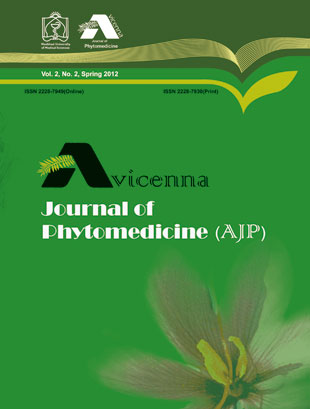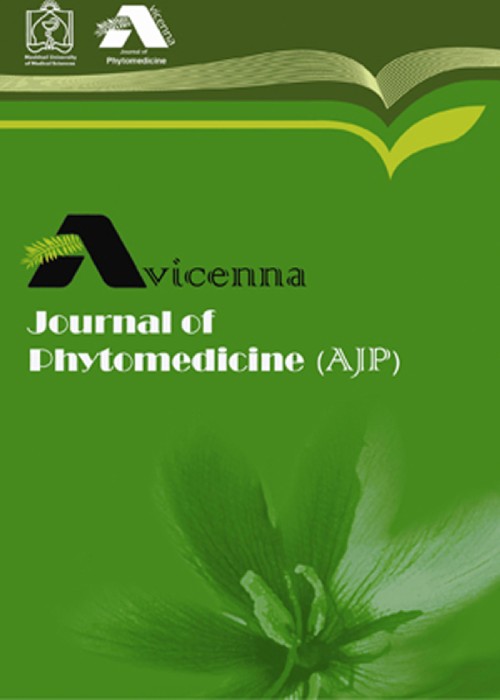فهرست مطالب

Avicenna Journal of Phytomedicine
Volume:2 Issue: 2, Spring 2012
- تاریخ انتشار: 1391/01/17
- تعداد عناوین: 8
-
-
Page 52ObjectiveMalaria is an infectious disease commonplace in tropical countries. For many years, major antimalarial drugs consisted of natural products, but since 1930s these drugs have been largely replaced with a series of synthetic drugs. This article tries to briefly indicate that some plants which previously were used to treat malaria, as a result of deficiencies of synthetic drugs, have revived into useful products once more. It also attempts to describe some tests which can be used to evaluate plant extracts for antimalarial activity.Materials And MethodsBy referring to some recent literatures, data were collected about plants used for the treatment of malaria, evaluation of plant extracts for antimalarial activity, modes of action of natural antimalarial agents, and recent research on antimalarial plants in Iran and other countries.Results andConclusionThere is an urgent need for the development of new treatments for malaria. Many countries have a vast precedence in the use of medicinal plants and the required knowledge spans many centuries. Although malaria is controlled in Iran, some researchers tend to study malaria and related subjects. In vitro biological tests for the detection of antimalarial activities in plant extracts are currently available. It is vital that the efficacy and safety of traditional medicines be validated and their active constituents be identified in order to establish reliable quality control measures.Keywords: Antimalarial plants, Malaria, Natural Products
-
Page 63ObjectivesDiabetes mellitus is associated with biochemical, physiological and pathological alterations in the liver. The aim of this study was to investigate the effects of hydroalcoholic extract of Prangos ferulacea (L.) Lindle (P.f) on changes in rats´ liver structure and serum activities of alanin and aspartate aminotransferases after alloxan injection.Materials And MethodsIn this study, forty female Wistar rats with body weight of 200±20 g were randomly divided into 5 groups with 8 rats per group. Diabetes was induced in rats by alloxan monohydrate at dose of 120 mg/kg body weight (BW) injected intraperitoneally. Root and leaves with stems hydroalcoholic extract of P.f at dose of 100 mg/kg BW were given orally in diabetic rats daily for a month.ResultsIn diabetic rats (D) the serum allanin aminotransferases (ALT) and aspartate aminotransferases (AST) were significantly increased (p<0.05) in comparison with the other groups. Moreover, in this group, necrosis of hepatocytes, cytoplasmic vacuolations, and lymphocytic inflammation were observed. Diabetic rats treated by root extract of P.f compared with diabetic group showed a significant decrease in these enzymes. In addition, in this group all of previous signs were improved.ConclusionRoot hydroalcoholic extract of P.f found to influence changes of aminotransferases and prevent the histopathological changes of liver associated with alloxan diabetes in rats.Keywords: ALT, AST, Diabetes mellitus, Histopathology
-
Page 72ObjectiveThe present study was undertaken to evaluate anti-depressant activity of Myristica fragrans(MS).Materials And MethodsMale Wistar rats were subjected to imipramine and herbal extract ofMS for their antidepressant activity using Forced Swimming Test (FST), Reserpine Reversal Test (RRT), Haloperidol-Induced Catalepsy (HIC), and Pentobarbitone Sleeping Time (PST).ResultsAdministration of MS and imipramine revealed a statistically significant reduction in immobility time in FST, RRT, and protection against HIC, compared to the control group. However, there was no significant potentiation of PST.ConclusionOur study demonstrated the potential antidepressant activity of MS.Keywords: Antidepressant activity, Imipramine, Myristica fragrans
-
Page 79ObjectivesPotato (Solanum tuberosum L.), as a whole food, contains high levels of vitamins and important antioxidants including phenolic acids, carotenoids and flavonoids. The objective of this study was to determine the total phenolic content and antioxidant activities of three common potatoes (Solanum tuberosum) cultivars in Iran i.e., Savalan, Agria and Sante.Materials And MethodsPhenolic compound extraction of samples was done with methanol and total phenolic on the basis of folin-ciocalteu assay was estimated as 16.58 to 36.24 mg GAE/100g dry sample. The antioxidant activities of potato extracts on the basis of inhibition of linoleic acid peroxidation and DPPH assay were compared with a commercially available antioxidant, α -tocopherol.ResultsSavalan had the highest phenolic content and the highest DPPH radical scavenging activity with EC50 value of 41.815±mg/ml (DB). Also Savalan had the best inhibitory action against linoleic acid oxidation at 94.10±1.89% at 50 mg/ml sample concentration. Methanolic potato extracts had better antioxidant activity than α-tocopherol. Significant (p<0.01) negative correlation was observed between total phenolic content and the EC50 for DPPH radical scavenging activity(R=-0.877), but there was no correlation between total phenolic content and total antioxidant activity.ConclusionMetanolic extracts of three potato cultivars are able to inhibit the oxidation process. The correlation between total phenolic content and DPPH radical scavenging activity indicates that phenolic compounds are responsible for antiradical activity.Keywords: Antioxidant activity, Potato, Radical scavenging, Total phenolic compounds
-
Page 86ObjectivesDatura Stramonium (DS) is a common weed along roadsides, in cornfields and pastures and in waste areas. It belongs to the family Solanaceae and its toxic components are tropane belladonna alkaloids. It has been used voluntarily by teenagers for its hallucinogenic effect. The plant is named in Iran as Tatoore. Symptoms and signs of acute D. Stramonium poisoning usually are similar to anticholinergic syndrome. This study is done in order to clarify the status of this poisoning in our region.Materials And MethodsThis study is a case series on all patients admitted to Imam Reza Hospital, Mashhad, Iran, with acute D. Stramonium poisoning between 2008 and 2011. We observed their symptoms, signs, routine laboratory test results and treatment used to control their symptoms.ResultsThere were 19 patients included in our study. Children were poisoned more commonly than teenagers and poisoning in adults was rare. All of the children ingested the plant accidentally. The most presenting symptom was irritability and the most common sign was sinus tachycardia. There was not any presentation of seizure or coma. Most of the symptoms were controlled by parenteral benzodiazepines and there were no need to use of cholinergic agents such as physostigmine.ConclusionOur study showed most of D. Stramonium poisoned population in our region are children. We suggest decreasing accessibility to the plant in order to decrease the incidence of its poisoning.Keywords: Alkaloids, Atropine, Cholinergic Antagonists, Datura Stramonium, Poisoning
-
Page 90ObjectiveParkinson's disease (PD) is one of the most common neurodegenerative disorders which is characterized by tremor, rigidity, bradykinesia and postural disturbances. Studies indicate that grape juice and exercise may have beneficial effects on neurodegenerative disorders. Therefore, in the present study, we evaluated the effects of red grape juice (GJ) together with treadmill running on animal model of PD.Materials And Methods30 male Wistar rats were divided randomly into Sham, PD, PD treated with GJ (PD-GJ), PD treated with exercise (PD-Ex), and PD treated with GJ associated with exercise (PD-GJ-Ex) groups with six rats in each. In order to obtain the PD model, 6-OHDA was infused into left substantia nigra pars compacta. In order to prove that the lesions are created and to estimate their extent, apomorphine was administered (i.p.) and total number of induced rotations was recorded during 60 minutes. Exercise was applied by treadmill and GJ was added into drinking water for 30 days and rotations test was performed again.ResultsOur results indicate that there was a significant difference in number of rotations between PD and Sham groups (p<0.05). At the end of experiment, number of rotations decreased significantly in both PD-GJ and PD-GJ-Ex groups (p<0.05). Exercise alone increased the number of rotations non- significantly.ConclusionGrape juice reduced rotations probably via the antioxidant agents.Keywords: 6, OHDA, Apomorphine, Parkinson's disease, Red grape juice, Rotational behavior, Treadmill running
-
Page 97ObjectiveCrocin, as an active constituent of saffron, has many biological functions including antioxidant and anti-inflammatory activities. The present study was aimed to investigate the effects of crocin and chlorpheniramine on local edema induced by histamine.Materials And MethodsLocal edema was induced by subcutaneous injection of histamine (100 μl, 0.1%) in ventral surface of right hind paw. The thickness of paw was measured at 1 h before and 1, 2, 3 h after injection of histamine, using a fine caliper. The number of neutrophils in paw tissue sections was counted 3 h after intraplantar injection of histamine.ResultsIntraperitoneal injection of crocin at doses of 100 and 200 mg/kg and chlorpheniramine at a dose of 10 mg/kg significantly (p<0.05) decreased both paw thickness and infiltration of neutrophils in paw tissues. In a combined treatment, intraperitoneal injection of an effective dose of crocin (100 mg/kg) with an ineffective dose of chlorpheniramine (2.5 mg/kg) produced a more documented response in comparison with crocin (100 mg/kg) and chlorpheniramine (2.5 mg/kg) used alone.ConclusionThe results suggested that both crocin and chlorpheniramine suppressed histamine-induced local paw edema. Moreover, histamine H1 receptors function may be affected by crocin.Keywords: Crocin, Chlorpheniramine, Histamine, Paw edema, Rats
-
Page 105ObjectiveMedicinal plants organize an effective source of folk and modern medicine. Correct identification, authentication and quality control are essential to ensure safety, therapeutic potency, efficacy and reproducible quality of herbal medicines. The aim of this study is to use taxonomic method for authentication of traditional herbal drugs which are commonly sold in herbal shops in Iran. In this regard, twenty-seven cases of herbal drugs suspected to be adulterated were investigated.Material And MethodsCrude raw material of herbal drugs was prepared from the various markets in Iran and was identified at the Ferdowsi University of Mashhad Herbarium (FUMH).ResultsTaxonomic evaluationrevealed that 78 species belonging to 21 families which are traded in Iranian market should be considered as authentic, adulterated and substituted samples.ConclusionIt was concluded that nowadays, many of the medicinal plants available in the market have ambiguous identification along with adulteration and contamination. The present study provides awareness amongst the traders, researchers, clinicians and manufacturing units about the ambiguity of authenticity in the traded herbal raw materials.Keywords: Adulteration, Authentication, Crude Herbs, Identification, Iran, Market


